Lever-action rifles have stood the test of time, being as viable today as they were in the 1860s. Theyve been chambered for nearly every pistol round, and for rifle (and shotgun!) cartridges up to the potent .450 Alaskan and others of even more power. We take a look here at two new offerings in highly practical calibers, both with interesting features and high overall usefulness. The two rifles are Marlins .308 MX ($590) and Brownings takedown BLR in .308 Winchester ($832).
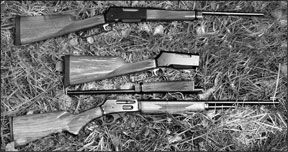
Marlin has once again come up with a new round for its lever-action line. However, unlike the .450 Marlin, this one makes a great deal of sense to us. The .308 MX is basically a semi-rimmed .308. Its one limitation, as of this writing, is that there is only one loading for it, by only one maker, Hornady. The round features a plastic-tipped bullet of 160 grains. On the other side of our balance sheet, Browning has just brought out a shiny new takedown rifle in a relatively light version with detachable and easily loaded box magazine. Its caliber is the time-proven .308, though the takedown is available in many calibers. How do the two stack up? Heres what we found.
Marlin .308 MX, $590
Our Marlin came with mighty nicely figured walnut. The buttstock wood matched the wood of the forend, both having prominent contrasting grain and some fiddleback. The wood appeared to have an epoxy-base finish, it being quite hard and scratch-resistant. The checkering was excellent, with decorative touches. It wrapped the forend and was generous at the grip. The butt had a hard-rubber pad that curved to fit the shoulder, though it did little to cut recoil. There were sling studs, too.
The bluing and overall fitting were excellent, though we could have
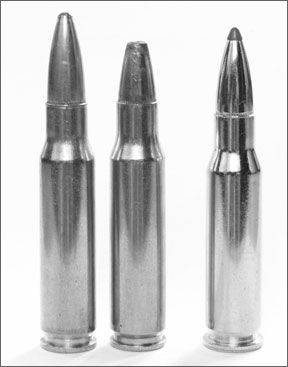
done without all the extra words of warning on the barrel. The sights consisted of a buckhorn rear with a U notch, and a hooded front having a large, flat, gold-faced bead. We thought a good aperture rear sight would have been the way to go, rather than the dated “cowboy” buckhorn rear. The rear sight had the old-style stepped adjustment for elevation, with windage by drifting. The action had well-polished flat sides with matte finish on top, and was fitted with a hammer-blocking cross bolt that could be used or ignored at will. The MX had the overall flavor of the old West, which we found pleasant. The fact that its ballistics match the .308 is cause for celebration, we thought.
The easily loaded tubular magazine held five rounds, and one could be added in the chamber for a total of six. The front of the magazine tube was secured to the barrel via a single screw going into a small carrier dovetailed into the barrel. We found the screw had worked loose after only a few shots. We snugged it up and then kept a wary eye on it, and found that it didnt want to stay perfectly tight during our extended test shooting. It seemed that as this screw came loose, accuracy tended to deteriorate slightly. However, the Marlin had accuracy to spare, even at its worst.
Feeding, firing and ejection were perfect. The lack of suitable padding in the token recoil pad led to our noticing the kick, but it was not substantial. For those shy of recoil, a softer pad might be appropriate. Our first sight-checking rounds of the iron sights gave us three shots touching at 25 yards, dead center, so it was not necessary to adjust anything. As noted, extraction and ejection
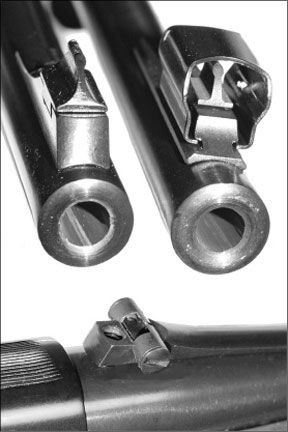
were strong and easy, and primers appeared to have flattening commensurate with reasonable pressure.
There was a trace of creep in the trigger, which broke at 5.5 pounds. We felt the future owner of this rifle ought to have that taken care of. With an empty weight of 7.3 pounds this wasnt a lightweight, but thats about the only thing we could complain about, concerning the Marlin. The balance and handling were superb. The lever was easy to work with the rifle at the shoulder. The rifle was easily carried with the hand wrapped around the action, which was the static balance point. However, a suitable scope would make the overall weight at least eight pounds, and thats a good reason to consider a good aperture sight instead of a scope, for those whose eyes permit this.
On the range we found the Marlin was simply outstanding. We made one of the smallest lever-rifle groups ever recorded, with three touching at 50 yards from the machine rest. The group measured just 0.4 inch, not bad for crude cowboy sights. Ejection was clean and easy, and the lever worked easily and smoothly throughout our test sessions. Rapid-fire working of the mechanism was easier, we felt, with the Marlin than with the BLR. We liked this rifle and its new cartridge.
Browning BLR LT WT 81
SA 034011118 $832
Right off the bat some of our test shooters didnt much care for the glass-like stock finish on the rather plain walnut of the BLR, but Browning lovers have come to expect that gloss whether the gun was made in Belgium in days of yore, or in Japan, as was this one. The fit and finish were exceptionally well done everywhere we looked, so wed say the Miroku people take pride in their products. The checkering was fully functional, though the gun was lacking in
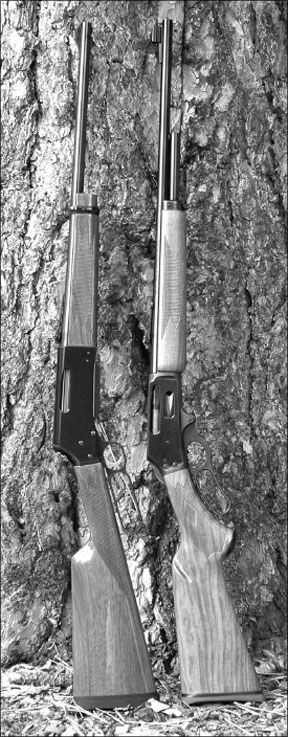
any kind of sling swivels or points of attachment. Perhaps thats appropriate for a takedown rifle.
The takedown feature was most interesting to us. The Browning came apart easily by simply pulling downward on the small lever at the rear of the forend, just in front of the magazine release. Pull the lever firmly until it comes down, and then pull the gun apart. This permits cleaning the bore from the breech, and also allows easy access to the front of the bolt. We found the fit of barrel to receiver to be quite tight, which ought to permit holding of a receiver-mounted scopes zero through the disassembly and reassembly process for a reasonably long time. However, the individual will have to determine for himself how much accuracy he can accept from the slight displacement of the barrel in relation to the scope whenever the rifle comes apart. Its not reasonable to expect cutting-edge accuracy from a takedown rifle with its scope mounted on the receiver, never mind the nonsense you see on TV about takedown sniper rifles packed into briefcases. Probably the best setup for the BLR would be to put the scope onto the barrel, scout-rifle style. Sure enough, the barrel had some drilled holes to make that an easy job, using the “Scout-Style Mount” sold on the company website (www.browning.com). These cost $70, require Weaver rings, and also require a suitable scope with the necessary long eye relief, but that would be a fast-handling and slick setup for this takedown rifle.
Although the trigger was virtually creep-free, we didnt think it was worthy of its gold plating. It broke at a way-too-heavy 7.6 pounds. The bolt opens slowly at first, cocking the wide hammer via a dual rack-and-pinion gear arrangement. As soon as the hammer cocks, the bolt flies back for the rest of its stroke with a resounding “clunk” that we found disconcerting. We found you cant just drop a shell in and close the bolt, like you can with the Marlin. You must load the chamber from the magazine. With a round in the chamber, the hammer can be lowered and another round put into the magazine. But that hammer isnt all that simple to lower. To safely lower the hammer you must press the trigger while restraining the hammer with your thumb. As soon as the hammer starts to move forward, release the trigger. Then the hammer cannot strike the firing pin. The hammer will come to rest in the half-cock position. The head of the hammer can then be pressed until it slips forward and downward, filling the gap between the hammer and action and further blocking the firing pin. Lowering that hammer onto a live round requires great care and practice in order to do it safely. The Marlin user, on the other hand, can deploy its cross-bolt feature and lower the hammer easily and in relative safety.
Though the aluminum-framed Browning was designated a lightweight, at 6.7 pounds empty it wasnt nearly as light as some of todays lightest rifles. We have a bolt-action rifle on hand, for example, that is a lot more powerful than either of the test guns, and it weighs under 5 pounds. Now thats a lightweight! Still, the BLR was a good half-pound lighter than the all-steel Marlin, and the takedown feature might make this an ideal rifle for the backpacker or airborne hunter. The BLR was light enough that it needed its recoil pad, and the pad was a good one.
The Browning had a detachable, four-round magazine (the website incorrectly states five rounds) that was not all that easy to remove when it was empty. Its sides protruded slightly out from the bottom edge of the action, and that was the only way to pull it out. The magazine fell free when it was perfectly clean, but we had fits getting it out when a round slid forward and got caught in
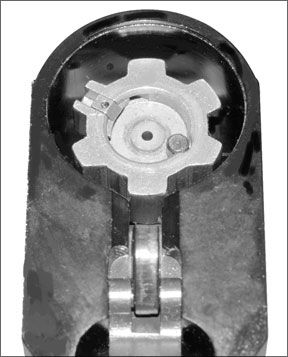
the works.
We tried the BLR with some older European-made ammo that was a touch on the hot side, and found the bolt didnt want to come back easily. The action nearly jammed, with the fired case stuck in the chamber. It took lots of force to open the bolt. When we switched to Winchester match fodder we had no more extraction problems, but did encounter another problem wed had with the hot European ammunition. On occasion the top round in the magazine would slide forward from recoil, and in the case of the pointed match ammunition, the bullet tip moved into an open area between the bottom of the feed ramp and the top lip of the magazine. The bolt ejected the fired case but jammed on the next round going forward. The stuck bolt made it necessary to remove the magazine forcefully to clear the problem. This open area needs to be filled, we thought. A simple filler block, even of poly, would cure the problem. We didnt notice this problem with the blunter-nosed Federal Power-Shok or the Remington 180-grain Core-Lokt test ammo. But we did notice the gear-driven rack-and-pinion bolt required significant force to get the fired Remington cases out. As long as cases didnt stick, this was a fast and slick system. But the double rack-and-pinion system of the BLR seems to have less leverage on the bolt than the Marlins straightforward setup.















